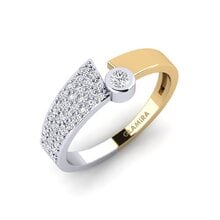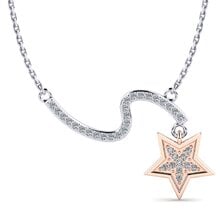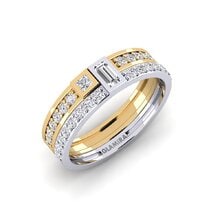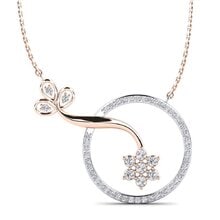
Two-Tone Jewellery Trends: Mixing Gold, Rose Gold, and White Gold Together
The Rise of Mixed Metal Jewellery

The blending of different metal tones in gold jewellery design has surged in popularity, reflecting a shift in aesthetic preferences and cultural expressions. Mixed metal jewellery—incorporating gold, rose gold, and white gold together—has become a focal point for those seeking versatile, bold, and elegant statement pieces.
A key factor driving the rise of mixed metal jewellery is its versatility. Pieces that combine multiple metal tones can seamlessly complement any outfit, whether casual or formal. The harmony created by mixing warm rose gold, classic yellow gold, and cool white gold appeals to individuals who enjoy balancing sophistication with modernity.
Jewellery designers are also leveraging advanced techniques to blend metals creatively. Common practices include interlacing metals in intricate patterns, layering contrasting tones, or incorporating subtle gradation effects where colours transition naturally across a piece. Such methods result in visually captivating jewellery that transcends singular styles.
Another advantage of mixed metal jewellery is its ability to pair well with other accessories and skin tones. For instance, rose gold’s warm hues complement earthy undertones, while white gold offers a crisp finish ideal for cooler undertones.
In addition to aesthetic appeal, owning mixed metal jewellery reflects cultural shifts towards individuality and self-expression. By celebrating differences and blending elements, mixed metal jewellery has become synonymous with modern elegance.
Understanding Gold, Rose Gold, and White Gold

Gold, rose gold, and white gold each possess unique characteristics that make them highly prized in jewellery design. Understanding their distinct compositions, appearances, and qualities can help in appreciating their appeal when combined in two-tone jewellery.
Gold, in its purest form, is a soft, malleable metal with an unmistakable vibrant yellow hue. It is often alloyed with other metals such as copper, silver, or zinc to enhance durability and make it suitable for jewellery. Pure gold is 24 carats (24ct), but for jewellery, lower carats like 18ct or 14ct are more common, reflecting a balance between purity and strength.
Rose gold is a blend of gold and copper, with the percentage of copper giving it the characteristic warm, pinkish-red tint. Its romantic tone has made it particularly popular in recent years. Rose gold is often favoured for its ability to blend seamlessly with both vintage and contemporary designs, offering versatility in two-tone combinations. Its durability is slightly higher than yellow gold due to the robustness of copper.
White gold, on the other hand, combines gold with white metals such as platinum, palladium, or silver. It is then rhodium-plated for a bright, lustrous finish resembling platinum. White gold’s cool undertone provides a modern, sleek aesthetic that contrasts nicely with the warmth of yellow or rose gold. However, the rhodium plating may require periodic reapplication to maintain its appearance.
These metals differ not just in colour but in durability, texture, and cost. Their contrasting qualities create a sophisticated interplay when used together, explaining why they are pivotal in the current two-tone jewellery trend. Understanding these characteristics is key to appreciating how they can harmoniously coexist in a single piece.
How to Mix Gold Tones with Confidence

Blending gold tones can create a visually rich and dynamic look, but it requires a thoughtful approach to ensure harmony. Whether combining yellow gold, rose gold, or white gold, the key lies in balancing contrasts while tying the elements together cohesively. Understanding how to approach this allows anyone to wear mixed gold tones with elegance and ease.
Match a Core Theme
Begin by establishing a consistent theme, such as floral-inspired designs or geometric shapes. A unifying theme helps the different gold tones feel intentional rather than random. For instance, a yellow gold bracelet with floral motifs pairs beautifully with rose gold earrings featuring a similar design.
Start Small
For those new to two-tone jewellery, it’s wise to begin with smaller accents before committing to statement pieces. A white gold dainty ring layered with a subtle rose gold band introduces variety without overwhelming the look. Gradual experimentation builds confidence while refining personal style preferences.
Balance Proportions
Strike a balance when mixing two or more gold tones. Opt for a dominant shade and let the others complement it. For example, a necklace with a yellow gold chain can feature a white gold or rose gold pendant for contrast without appearing overdone.
Choose Versatile Pieces
Jewellery that already combines two or more gold tones can act as a bridge between other accessories. A two-tone gold watch or a ring featuring all three shades can effortlessly unite multiple pieces in an outfit.
Coordinate Closely
When mixing gold tones, other outfit elements like clothing and makeup should be kept neutral to let the jewellery stand out. Muted hues like beige, grey, or white provide an understated canvas for showcasing two-tone combinations.
Layering and Stacking Mixed Metal Pieces

Layering and stacking jewellery with mixed metal tones, such as gold, rose gold, and white gold, offers a stylish approach to accessorising and creates a visually dynamic effect. The technique involves blending different metal shades in harmony, showcasing their distinct qualities while crafting a cohesive aesthetic. This trend enables individuals to experiment with colour contrasts and textures, emphasising personal style.
To layer mixed metal necklaces effectively, the length and thickness of the chains should vary. Combining a delicate rose gold chain with a bold white gold pendant or incorporating a chunky gold statement piece with slimmer designs provides depth and balance. Layering a choker in white gold with a longer piece in rose or yellow gold can also frame the neckline beautifully.
Stacking rings with mixed metals demands intentionality. A white gold band layered with a rose gold infinity ring, followed by a yellow gold textured piece, creates a striking composition. For variety, consider blending plain bands with gemstone-studded designs. Allowing negative space between rings can prevent overcrowding and keep the look refined.
When layering bracelets, mixing textures enhances visual interest. A rose gold bangle paired with a white gold chain bracelet and a yellow gold cuff can produce an intricate stacked arrangement. Complement these with an accent piece featuring multi-tone elements, such as a bracelet interweaving all three metals.
Earrings can also be artfully combined for an asymmetric look. Pairing studs or hoops in white gold on one ear with a gold ear cuff or rose gold drop earring on the other creates a contemporary feel, adding playful balance.
Incorporating Gemstones for Added Contrast
In two-tone jewellery designs, incorporating gemstones offers an elegant way to heighten contrast and add visual intrigue. By pairing gold, rose gold, and white gold with complementary or contrasting gemstones, jewellery can transform into statement pieces that merge colour, brilliance, and texture.
Specific gemstones naturally highlight particular tones of metal. For instance, diamonds are a timeless pairing across all gold hues. Their neutral brilliance reflects and enhances the interplay of metals, allowing the two-tone design to shine without overwhelming the piece. On the other hand, coloured gemstones, such as sapphires, rubies, and emeralds, create a striking counterpoint against mixed metal backdrops. A sapphire, set in white gold with a rose or yellow gold frame, immediately stands out, drawing the eye to both the stone and the surrounding metals.
Gemstone cuts also play a significant role in emphasising two-tone contrast. Round and oval cuts pair well with classic designs, while geometric cuts like emerald or princess can lend a modern feel. Combining simple gemstone shapes with intricate metalwork can produce a balance between boldness and elegance in any piece.
Layering gemstones within the design further enhances depth. Pave settings can border different gold tones, creating a seamless blend of colour transitions. Alternatively, bezel-set coloured stones act as striking dividers between metal sections, offering clarity and definition.
When selecting gemstones for two-tone jewellery, considerations about durability, maintenance, and personal preferences are crucial. Hard stones such as diamonds and sapphires work well for everyday pieces, while softer options like pearls or opals are best suited for occasional wear.
Styling Mixed Metals for Different Occasions

Blending gold, rose gold, and white gold has become a versatile choice for various occasions, from casual outings to formal events. By understanding the nuances of mixed-metal jewellery, individuals can tailor their look, ensuring it matches the setting while remaining stylish.
Everyday Look
For casual occasions like brunches, errands, or weekend getaways, incorporating mixed-metal jewellery can add subtle sophistication. A stack of delicate rings featuring gold, rose gold, and white gold creates a laid-back yet polished appearance. Pairing a mixed-metal pendant necklace with a simple white tee and jeans strikes the right balance between relaxed and trendy. Layered bracelets in two or three metal hues complement this aesthetic, offering understated charm.
Professional Settings
Office wear can be enhanced with mixed-metal jewellery when styled tastefully. Opting for minimalist designs, such as a rose gold and white gold bangle or gold stud earrings with white gold accents, ensures a professional yet distinct look. A mixed-metal watch can also serve as a functional yet stylish choice for the workplace, blending well with tailored suits or smart-casual ensembles. The key is to keep the design streamlined and not too flashy.
Elegant Evenings
For formal occasions such as weddings, galas, or dinners, bold mixed-metal statement pieces are ideal for creating striking yet sophisticated impressions. A two-tone necklace combining rose gold and gold can highlight necklines beautifully, while chandelier earrings with white gold and rose gold elements exude elegance. Adding a dramatic, multi-metal cocktail ring as a focal accessory can enhance evening wear while harmonising with other metal tones.
Special Celebrations
During anniversaries, birthdays, or festive gatherings, more creative and eclectic mixed-metal combinations can be explored. A rose gold and white gold charm bracelet or layered necklaces blending all three tones offers a celebratory, personalised flair. Complement these with mixed-metal hoop earrings to create a cohesive yet joyful appearance.
Styling mixed metals thoughtfully ensures every occasion is graced with an individualistic yet harmonised look.
Two-Tone Designs in Engagement and Wedding Rings

Two-tone designs in engagement and wedding rings have grown increasingly popular, offering a unique take on timeless traditions. By blending different shades of gold—yellow, white, and rose—these pieces create striking visual contrasts while adding depth and sophistication to the jewellery. This trend caters to couples seeking something modern yet classic for their special rings.
Designers often use the two-tone technique to emphasise intricate details. For example, a rose gold halo around a white gold centre stone can accentuate the brilliance of the gem, while a yellow gold band paired with white gold embellishments adds dimension. This blend of metals can help elevate conventional designs, including solitaire, halo, and vintage-inspired rings.
Customisation is another appealing aspect of two-tone engagement rings and wedding rings. Wearers can pair their chosen metals to express personal style or reflect meaningful symbolism. For instance, rose gold can signify romance, while yellow gold represents tradition, and white gold exudes elegance. Together, these shades create a narrative that mirrors the couple’s unique love story.
Two-tone designs also allow greater flexibility when matching other jewellery. A ring with dual metals can coordinate with both gold and silver pieces, creating a versatile and cohesive aesthetic. This feature makes two-tone rings a practical yet stylish choice for daily wear.
When choosing two-tone rings, it is important to evaluate the quality of the metals. Rings crafted from 14k or 18k blends are durable and retain their lustre over time, making them an excellent long-term investment.
Matching Accessories for a Balanced Look

Achieving a balanced aesthetic when wearing two-tone jewellery involves thoughtful coordination of accessories. The interplay between gold, rose gold, and white gold can be complemented or enhanced by selecting pieces that unify the look without overwhelming the overall style. Accessories serve as an anchoring element, tying together disparate tones to create a harmonious appearance.
Consider Colour Coherence
When mixing metals in jewellery, it is essential to ensure that accessories share a coherent colour scheme. Neutral tones, such as beige, cream, or grey, work well to balance the vivid contrasts of the metals. For more vibrant outfits, opting for accessories featuring one of the dominant metallic shades—gold, rose gold, or white gold—can help to maintain visual unity.
Texture and Material Selection
The texture and material of accessories should complement the jewellery without competing for attention. For instance, leather accents with subtle metallic detailing work seamlessly with two-tone jewellery. Satin, velvet, or mirrored finishes also provide understated elegance, pairing beautifully with mixed metal jewellery designs.
Layered Accessories
Layering accessories with mixed metals is another way to create a balanced look. Delicate chains or bangles featuring gold and white gold can blend effortlessly with two-tone jewellery, helping to distribute the interplay of colour across the outfit. Rings with intertwined metallic details can also add a cohesive touch.
Footwear and Handbags
Footwear or handbags with metallic embellishments can further enhance a balanced look. Pay attention to hardware accents—gold buckles or rose gold clasps can echo the tones in two-tone jewellery and unify the outfit overall. Choosing neutral-coloured items with metallic hints is ideal when mixing three shades.
“Accessories should elevate rather than distract, ensuring the jewellery remains a focal point while the entire look appears seamless.”
Incorporating well-matched accessories allows the wearer to emphasise the beauty of their two-tone pieces without creating visual discord. The key lies in achieving contrast with coordination and harmony with variety.
Common Mistakes to Avoid When Mixing Metals

Mixing metals in jewellery styling can elevate the overall look, but it is essential to bypass common pitfalls that may undermine the balance and beauty of the pieces. Understanding these errors ensures a harmonious blend of gold, rose gold, and white gold, empowering individuals to achieve a polished, cohesive aesthetic.
Focusing Too Heavily on One Metal
Relying heavily on a single metal while neglecting others can disrupt the intended two-tone or tri-tone equilibrium. For example, layering multiple yellow gold pieces with just one white gold item may fail to create visual balance, leading to an overwhelming or poorly coordinated appearance.
Ignoring Skin Tone and Personal Style
Neglecting skin tone compatibility is another critical mistake. Certain metals, such as rose gold, may complement warm undertones, while cooler tones pair seamlessly with white gold. Dismissing personal preferences and natural colouring can result in a mismatched and unflattering aesthetic.
Overcomplicating the Layers
Mixing metals works best when simplicity drives the design. Overloading with multiple jewellery pieces in various metals can create a cluttered appearance. Avoiding excess allows the focus to centre on the interplay between gold tones.
Using Conflicting Jewellery Styles
Combining metals in styles that clash—such as ornate vintage pieces paired with minimalist contemporary designs—can muddle the overall aesthetic. Opting for designs with complementary features ensures that the pieces work harmoniously together.
Disregarding Proportions
Not paying attention to proportions, such as pairing chunky gold bracelets with slim white gold rings, may unsettle the visual harmony. Keeping sizes and shapes cohesive ensures each metal contributes to the overall look without overpowering the others.
Failing to Coordinate Overall Outfit
Another common oversight is neglecting how mixed-metal jewellery interacts with clothing. Metals can either enhance or clash with wardrobe elements. Coordinating jewellery to complement outfit tones and textures ensures a balanced presentation.
By observing these guidelines, one can master the art of mixing metals while avoiding design missteps.
Express Your Unique Style with GLAMIRA

Two-tone jewellery is the epitome of artistic craftsmanship, offering a harmonious blend of elegance and personal expression. At GLAMIRA, this concept is taken to the next level, allowing individuals to design and personalise pieces that speak to their unique style and personality. The combination of gold, rose gold, and white gold creates captivating contrasts and complementary tones that suit every personal preference and occasion.
GLAMIRA provides the flexibility to customise jewellery to match individual tastes. Whether it’s pairing a rose gold band with white gold accents for an engagement ring or combining a yellow gold pendant with a white gold chain for a modern necklace, the possibilities are endless. Their selection allows customers to experiment with textures, finishes, and colour patterns seamlessly, ensuring that no two pieces are alike.
For those seeking distinctive designs, GLAMIRA’s catalogue offers inspiration. A dual-tone bracelet can exude charm through intricate combinations, while earrings mingling all three metals display timeless sophistication. Wearers can also customise gemstones to further personalise the look. For instance, adding a diamond or coloured gemstone can infuse brilliance and enhance contrast within the mixed metals.
Another unique offering is the ability to engrave pieces, adding a personal touch to the two-tone trends. A rose gold and white gold ring can feature a special message, creating a timeless keepsake. These bespoke options empower individuals to use jewellery not only for adornment but as a means of storytelling.
The versatility of GLAMIRA’s creations ensures that two-tone jewellery remains a cherished choice for any jewellery lover.


















